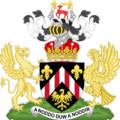| Earl of Snowdon | |
|---|---|
 | |
| Creation date | 6 October 1961 |
| Created by | Elizabeth II |
| Peerage | United Kingdom |
| First holder | Antony Armstrong-Jones, 1st Earl of Snowdon |
| Present holder | David Armstrong-Jones, 2nd Earl of Snowdon |
| Heir apparent | Charles Armstrong-Jones, Viscount Linley |
| Remainder to | the 1st Earl's heirs male of the body lawfully begotten |
| Subsidiary titles | Viscount Linley Baron Armstrong-Jones (1999–2017) |
Earl of Snowdon is a title in the Peerage of the United Kingdom. It was created in 1961, together with the subsidiary title of Viscount Linley, of Nymans in the County of Sussex, by Queen Elizabeth II for her then-brother-in-law, Antony Armstrong-Jones, [2] who married Princess Margaret in 1960.



